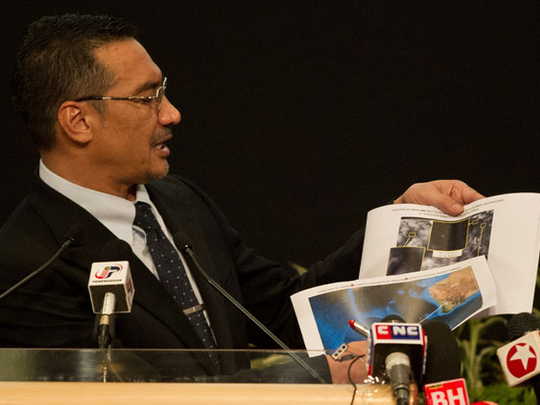
PERTH, Australia: Malaysia says a satellite has captured images of 122 objects in the Indian Ocean that might be from the missing plane.
Defence Minister Hishammuddin Hussein says the objects were seen close to where three other satellites previously detected objects.
He said on Wednesday the sightings together are "the most credible lead that we have."
Hishammuddin said the images were taken on Sunday and were relayed by French-based Airbus Defense and Space. Hishammuddin says the objects ranged in length from one meter to 23 meters.
Various floating objects have been spotted by planes and satellites, but none has been retrieved or identified.
Weather improves
PERTH: Planes and ships converged on the southern Indian Ocean on Wednesday, resuming the hunt for wreckage from Flight MH370 after weather conditions improved, as grieving passengers' families demand answers about the ill-fated jet.
Gale force winds, driving rain and mountainous seas prevented any sorties being flown from Perth in Australia's west on Tuesday, but 12 aircraft were deployed on Wednesday, with South Korean planes joining the hunt for the first time.
"Today's search is split into three areas within the same proximity, covering a cumulative 80,000 square kilometres (30,000 square miles)," said the Australian Maritime Safety Authority, which is coordinating the operation.
Australian naval vessel the HMAS Success, which was forced to leave the storm-tossed region, has returned and was conducting a surface sweep of a zone where two objects were spotted this week.
AMSA said four Chinese ships had also reached the search area, in the quest to find physical proof that the Malaysia Airlines jet went down in the remote seas, and clues as to why it veered off course and vanished on March 8 with 239 passengers and crew on board.
Australian Prime Minister Tony Abbott said the search - now in a recovery phase - would continue until there was no hope of finding anything.
"It is not absolutely open-ended but it is not something we will lightly abandon," he said ahead of a moment of silence in parliament in Canberra for victims of the doomed flight which included six Australians.
"The crash zone is about as close to nowhere as it's possible to be, but it's closer to Australia than anywhere else," he added in underscoring the remoteness of the search area as authorities seek to retrieve sunken or floating debris and the "black box" flight recorder.
Malaysia says search to shift to smaller area
Kuala Lumpur: Malaysia said Tuesday that it has narrowed the search for a downed jetliner to an area the size of Alaska in the southern Indian Ocean, while Australia said improved weather would allow the hunt for possible debris from the plane to resume.
The comments from Defence Minister Hishammuddin Hussein came a day after the country’s prime minister announced that a new analysis of satellite data confirmed the plane had crashed in a remote part of the southern Indian Ocean, killing all 239 aboard.
But the searchers will face a daunting task of combing a vast expanse of choppy seas for suspected remnants of the aircraft sighted earlier.
“We’re not searching for a needle in a haystack — we’re still trying to define where the haystack is,” Australia’s deputy defence chief, Air Marshal Mark Binskin, told reporters at a military base in Perth, Australia, as idled planes stood behind him.
There had been two corridors — based on rough satellite data — for the search. Hishammuddin said operations had been halted in the northern corridor that swept up from Malaysia toward Central Asia, as well as in the northern section of the southern corridor that arches down from Malaysia toward Antarctica.
That still leaves a large area of 1.6 million square kilometres, but just 20 per cent of the area that was previously being searched.
In remarks to the Malaysian Parliament on Tuesday, Prime Minister Najeeb Razak cautioned that the search will take a long time and “we will have to face unexpected and extraordinary challenges.”
Late Monday, Razak announced that the Boeing 777 had gone down in the sea with no survivors. That’s all that investigators and the Malaysian government have been able to say with certainty about Flight 370’s fate since it disappeared on March 8 shortly after taking off from Kuala Lumpur for Beijing.
Left unanswered are many troubling questions about why it was so far off course. Experts piecing together radar and satellite data believe the plane back-tracked over Malaysia and then travelled in the opposite direction to the Indian Ocean.
Investigators will be looking at various possibilities including mechanical or electrical failure, hijacking, sabotage, terrorism or issues related to the mental health of the pilots or someone else on board.
“We do not know why. We do not know how. We do not know how the terrible tragedy happened,” the airline’s chief executive, Ahmad Jauhari Yahya, told reporters.
The conclusions were based on a thorough analysis of the brief signals the plane sent every hour to a satellite belonging to Inmarsat, a British company, even after other communication systems on the jetliner shut down for unknown reasons.
The latest satellite information does not provide an exact location but just a rough estimate of where the jet crashed into the sea.
Although there have been an increasing number of apparent leads, there has been no confirmed identification of any debris.
“A visual search will resume tomorrow when the weather is expected to improve after gale force winds and heavy swells resulted in the suspension of the search operation on Tuesday,” said the Australian Maritime Safety Authority, which is overseeing the search out of Perth, Australia.
There is a race against the clock to find any trace of the plane that could lead searchers to the black boxes, whose battery-powered “pinger” could stop sending signals within two more weeks. The batteries are designed to last at least a month.
Several countries have begun moving specialised equipment into the area to prepare for a search for the plane and its black boxes, the common name for the cockpit voice and data recorders, needed to help determine what happened to the jetliner.
Hishammuddin said a US Navy deep-sea black box locator was on its way to Australia and would be installed on an Australian navy support vessel, the Ocean Shield, that was expected to arrive in several days.
There are 26 countries involved the search, and Hishammudin said the problems now facing the hunt to recover Flight 370 are not diplomatic “but technical and logistical.”
TheUS Navy has also sent an unmanned underwater vehicle to Perth that could be used if debris is located, said Rear Adm John Kirby, a Pentagon spokesman.
Australian Prime Minister Tony Abbott said he had spoken to Najib to offer help with the ongoing search and investigation.
“What up until now has been a search, moves into a recovery and investigation phase,” Abbott said. “I have offered Malaysia, as the country legally responsible for this, every assistance and cooperation from Australia.”
The search for the wreckage and the plane’s recorders could take years because the ocean is up to 7,000 meters deep in some parts. It took two years to find the black box from an Air France jet that went down in the Atlantic Ocean on a flight from Rio de Janeiro to Paris in 2009, and searchers knew within days where the crash site was.
“We’ve got to get lucky,” said John Goglia, a former member of the US National Transportation Safety Board. “It’s a race to get to the area in time to catch the black box pinger while it’s still working.”














